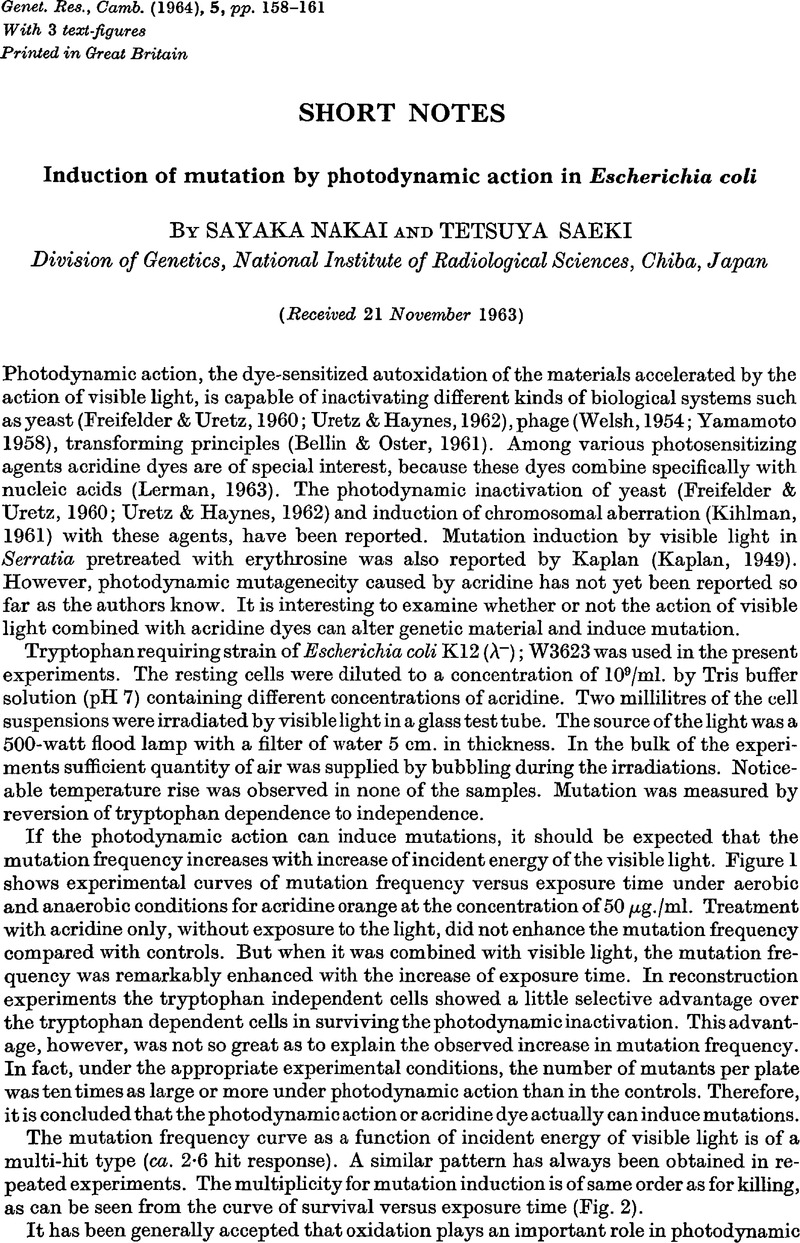Crossref Citations
This article has been cited by the following publications. This list is generated based on data provided by Crossref.
Brockman, H. E.
and
Goben, Wini
1965.
Mutagenicity of a Monofunctional Alkylating Agent Derivative of Acridine in
Neurospora
.
Science,
Vol. 147,
Issue. 3659,
p.
750.
Zampieri, Antonio
and
Greenberg, Joseph
1965.
Mutagenesis by acridine orange and proflavine in Escherichia coli strain S.
Mutation Research/Fundamental and Molecular Mechanisms of Mutagenesis,
Vol. 2,
Issue. 6,
p.
552.
Ritchie, D.A.
1965.
The photodynamic action of proflavine on phage T4.
Biochemical and Biophysical Research Communications,
Vol. 20,
Issue. 6,
p.
720.
Ritchie, D. A.
1965.
Mutagenesis with light and proflavine in phage T4 II. Properties of the mutants.
Genetical Research,
Vol. 6,
Issue. 3,
p.
474.
Brendel, M.
and
Winkler, U.
1966.
Photodynamische Inaktivierung des E. coli-Phagen T4: Untersuchung der Kreuzungsreaktivierung und des Schutzeffekts von Spermin.
Zeitschrift für Vererbungslehre,
Vol. 98,
Issue. 1,
p.
41.
Warr, J. R.
McVittie, A.
Randall, John
and
Hopkins, J. M.
1966.
Genetic control of flagellar structure inChlamydomonas reinhardii.
Genetical Research,
Vol. 7,
Issue. 3,
p.
335.
Nagata, Chikayoshi
Kodama, Masahiko
Tagashira, Yusaku
and
Imamura, Akira
1966.
Interaction of polynuclear aromatic hydrocarbons, 4‐nitroquinoline 1‐oxides, and various dyes with DNA.
Biopolymers,
Vol. 4,
Issue. 4,
p.
409.
Cramer, W.A.
and
Uretz, R.B.
1966.
Acridine orange-sensitized photoinactivation of the capacity of Escherichia coli for bacteriophage T4.
Virology,
Vol. 28,
Issue. 1,
p.
142.
Winkler, Ulrich
1966.
Fortschritte der Botanik.
p.
172.
Malling, H.V.
1966.
Hydroxylamine as a mutagenic agent for Nuerospora Crassa.
Mutation Research/Fundamental and Molecular Mechanisms of Mutagenesis,
Vol. 3,
Issue. 6,
p.
470.
Cramer, W.A.
and
Uretz, R.B.
1966.
Acridine orange-sensitized photoinactivation of T4 bacteriophage.
Virology,
Vol. 29,
Issue. 3,
p.
462.
SIMON, M.I.
1967.
Photobiology, Ionizing Radiations.
Vol. 27,
Issue. ,
p.
137.
Semmel, Marianne
and
Daune, Michel
1967.
Études des complexes de colorants basiques avec le RNA.
Biochimica et Biophysica Acta (BBA) - Nucleic Acids and Protein Synthesis,
Vol. 145,
Issue. 3,
p.
561.
DELMELLE, MICHEL
and
DUCHESNE, JULES
1968.
Molecular Associations in Biology.
p.
299.
Calberg-Bacq, Claire M.
Delmelle, M.
and
Duchesne, J.
1968.
Inactivation and mutagenesis due to the photodynamic action of acridines and related dyes on extracellular bacteriophage T4B.
Mutation Research/Fundamental and Molecular Mechanisms of Mutagenesis,
Vol. 6,
Issue. 1,
p.
15.
Brendel, Martin
1968.
Induction of mutation in phage T4 by extracellular treatment with methylene blue and visible light.
Molecular and General Genetics MGG,
Vol. 101,
Issue. 2,
p.
111.
Spikes, John D.
1968.
Photophysiology.
p.
33.
Lenci, F.
and
Delmelle, M.
1969.
ESR study of the photosensibilization of biomolecules.
Il Nuovo Cimento B Series 10,
Vol. 62,
Issue. 1,
p.
130.
Bellin, J.S.
Lutwick, L.
and
Jonas, B.
1969.
Effects of photodynamic action on E. coli.
Archives of Biochemistry and Biophysics,
Vol. 132,
Issue. 1,
p.
157.
SPIKES, JOHN D.
and
LIVINGSTON, ROBERT
1969.
Vol. 3,
Issue. ,
p.
29.



